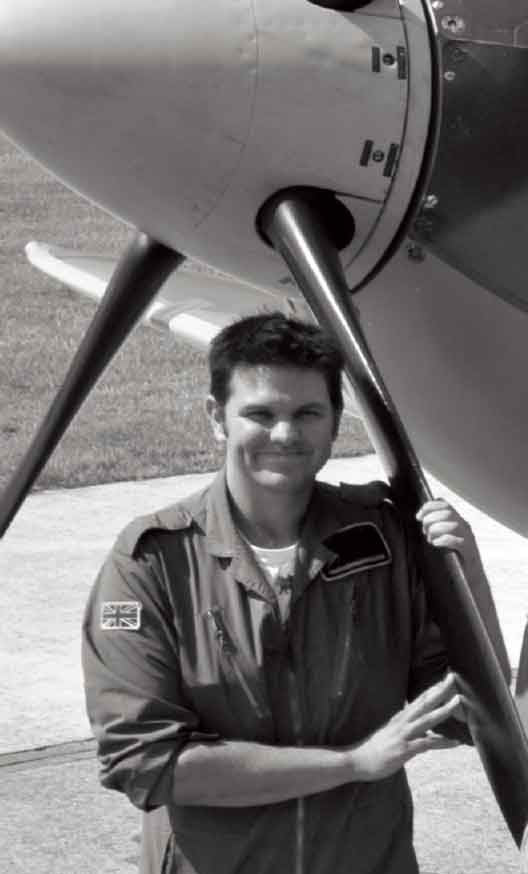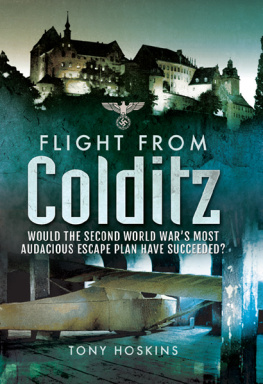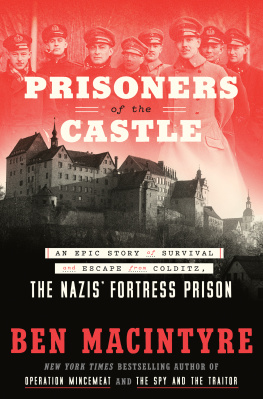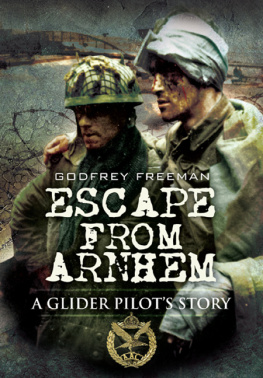
FLIGHT FROM COLDITZ
Would the Second World Wars Most Audacious Escape Plan Have Succeeded?
This edition published in 2016 by Frontline Books,
an imprint of Pen & Sword Books Ltd,
47 Church Street, Barnsley, S. Yorkshire, S70 2AS
Copyright Tony Hoskins, 2016
The right of Tony Hoskins to be identified as the author of this work has been asserted by him in accordance with the Copyright, Designs and Patents Act 1988.
ISBN: 978-1-47384-854-2
PDF ISBN: 978-1-47384-857-3
EPUB ISBN: 978-1-47384-855-9
PRC ISBN: 978-1-47384-856-6
All rights reserved. No part of this publication may be reproduced, stored in or introduced into a retrieval system, or transmitted, in any form, or by any means (electronic, mechanical, photocopying, recording or otherwise) without the prior written permission of the publisher. Any person who does any unauthorized act in relation to this publication may be liable to criminal prosecution and civil claims for damages.
CIP data records for this title are available from the British Library
For more information on our books, please visit
www.frontline-books.com,
email
or write to us at the above address.
Printed and bound by CPI Group (UK) Ltd, Croydon, CR0 4YY [TBC]
Typeset in 10.5/13.25 point Palatino
Contents
by Regina Thiede
Foreword
by Regina Thiede

I n its 1,000 year history Colditz Castle has seen much change and its glamorous days as a royal dwelling now lie far in the past. In the early 16th century, Colditz was one of the favourite castles of the Elector of Saxony, Frederick the Wise. However, in the ensuing centuries, the huge architectural ensemble was put to more utilitarian use and it served variously as a workhouse, mental asylum, prison, PoW camp and hospital. In Eastern Germany the remains of the magnificent furnishings from the Renaissance vanished under practical hospital walls, as did the escape tunnels dug by the Allied prisoners of war who were detained here. German historians have tended to overlook Colditz Castle and very little research was undertaken until recently.
In 2003, when Colditz Castle was included in the group of state-owned Saxon palaces, castles and gardens (Staatliche Schlsser, Burgen und Grten Sachsen gGmbH), it was in a ruinous state. Since then, about 20m have been invested to repair roofs, renovate facades, conserve ceiling paintings and preserve the escape tunnels.
The precious remnants of the Renaissance furnishings are in close proximity to the sites of famous escape attempts. The tunnel in the Dutch Buttress, for instance, crosses the last remaining Saxon garderobe pit (lavatory) of Frederick the Wise in Saxony. The wall of the Kirchenhaus, which the Allied prisoners had planned to break through in order to launch their glider, dates back to the fifteenth century and thus it was out of the question to destroy it for the glider project in 2012. In the process of restoration and rebuilding, the staff in the castle are constantly challenged with how best to preserve disparate elements from various periods.

In fact, the discussions have only just started. The Kirchenhaus is the first building which has been fully restored; in the Kellerhaus just the historical ceiling paintings have been preserved. The larger part of the castle is still waiting to be rediscovered and it is not yet open to the public. We hope to undertake further building projects in the next few years, including to restore the Kellerhaus and the Frstenhaus to open a large new museum which will display all the periods and different uses of Colditz Castle. Many of the stories here could be told in the places where they actually happened as the whole castle is a lively institution integrating 600 years of building history and only a few things have been completely demolished. This means visitors will not find themselves in an old-fashioned exhibition where everything is in chronological order, but that they will be able to experience the varied web of history where it happened in an interesting and colourful way.
When I learned that the film team led by Tony Hoskins was going to come to Colditz in March 2012 to reconstruct and launch the famous glider, I was afraid that the entire project would be thwarted by the foul weather of an early German spring. Luckily things turned out differently. The project was blessed by a constant high pressure front and on 17 March the glider was launched into a crystal-clear sky. These were the craziest and most exciting fourteen days I ever had in my job at Colditz Castle, since the film team was as enthusiastic about the castle and its history as I am. They generated as much positive energy at this permanent construction site as I have ever experienced here. The media response was enormous and the number of visitors in the following summer literally exploded.
The present co-operation with the British and with all the other nations who are connected by the dark periods of the last century is a wonderful experience. It helps us in planning and constructing the museum and it inspires our work here at Colditz.
Regina Thiede
Curator, Colditz Castle
October 2015
Introduction

A s our interest in the military machinery of the two world wars continues to thrive year on year and the generation who lived through the last world conflict for real slowly leave us, our only exposure to the ingenuity and sacrifices made by those men and women of the early 20th Century is in the books, the museums, and the factual documentaries made by those keen to tell their stories to a wider audience.
The technological advances made during the six bloody years of the Second World War were both considerable and rapid. Born entirely out of the need to defeat the opposing countries armed forces, the progression of the war machine grew at such a rate that our understanding of engineering advanced comparatively decades ahead of where it been in the 1930s.
Whilst the cars of the day sported wire-spoke wheels, manual magneto advance and wooden chassis, the front line fighters built of the latest alloy materials flew hundreds of miles at speeds in excess of 300mph and regularly to heights previously only achieved on special record-breaking flights. The desire to deliver bigger, faster and heavier steel projectiles brought about bigger airframes, more powerful engines and increasingly sent the young generation of the time off across the skies, seas and lands of Europe.
Many of that time did not return home, the fortunate ones of those finding themselves in the prison camps of countries such as Germany and Poland. Here their resolve to fight did not wain and in line with the directives given in their training, they continued with their duties of escape and evasion.
My interest in this period has been with me since I was a little boy. For at least twenty-five years I have followed their actions, and consider myself fortunate to have been involved with a number of exciting ventures and projects in that time. Being asked to be a part of the Colditz glider project was an opportunity to not only bring the incredible achievement of those prisoners of war to a greater audience, but to also discover first hand some of the challenges faced by these men.
Next page














